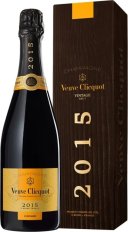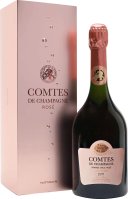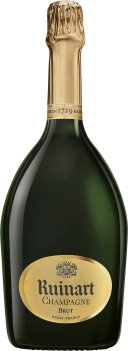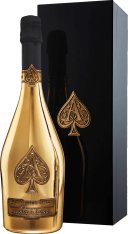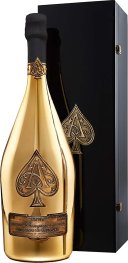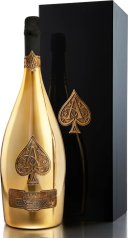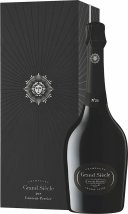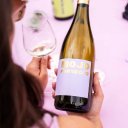Any price
Veuve Clicquot Vintage
Veuve Clicquot is widely regarded as one of the great Champagne houses. A pioneer in Champagne, Madame Clicquot's legacy can still be tasted in every bottle of Veuve. The Vintage by Veuve is a typically generous and full-bodied style of Champagne with all the toastiness and notes of brioche lover of Veuve have come to expect.
Taittinger Comtes De Champagne Rose
Its superb maturity tantalizes all the senses with a deep pink robe highlighted with glints of copper, an extremely delicate persistent effervescence, a nose of crushed strawberries, lime and liquorice underlined by a hint of roast coffee and cacao. The palate is entranced by a variation of gourmet sensations. The fresh, precise and taut attack gives way to reveal a supple, molten and heady structure. The finish imparts fruity notes underscored by a saline freshness. With the purity of its precise, gourmet aromatic structure, the Comtes de Champagne Rosé is perfectly in line with its predecessors and promises to offer excellent ageing potential.
Billecart Salmon Brut Reserve Non-Vintage
NV Billecart Salmon Brut Reserve, A satiny white mousse sits well over a straw pale gold tinged base that’s finely threaded by a steady stream of delicate bubbles. Strong yeasty baked bread characters intermingle with oily toast, cashew, citrusy honey and brioche notes. Rich yet tense and tightly knit on the finish the palate features mouthwatering flavours of baked bread, citrus, oily toast like characters and yeast lees with some roasted almonds on the dry crisp finish. Long precise aftertaste that has a lingering subtle dried nut element to it. A very dry and focused Champagne that requires some patience.
Ruinart R de Ruinart Brut Non-Vintage
The blend is 100% Chardonnay from various years (20 to 25% of which are reserve wines from the 2 previous years). A large majority of Premiers Crus from the Côte des Blancs and Montagne de Reims vineyards for aromatic refinement, supplemented by Sézannais wines known to provide maturity. Finally, several wines from the north of the Vesle valley give a light, fresh touch.
Billecart Salmon Cuvée Louis Blanc de Blancs
Founded in 1818 by husband and wife Nicolas François Billecart and Elisabeth Salmon, the Billecart-Salmon House is rich with history. For nearly two hundred years, the Billecart family has been handing down the secrets to making exceptional champagne from generation to generation. The Champagne House is special for many reasons, but one notable reason is that it is one of very few to remain Family owned. The Billecart-Salmon House covers around 50 hectares, and gets its grapes from a total of 170 hectares of land. Frequently cited for the quality of its vintages, the House pays particular attention to selecting the best grapes.
Armand de Brignac Ace of Spades Brut
The first release from Champagne Armand de Brignac, the Brut Gold remains the most iconic cuvée in the range. Rich with the old-world tradition of champagne blending, it is a trio of vintages from some of the most lauded terroirs of the region, resulting in a cuvée expressing vibrant and fresh fruit character with a soft texture. The striking gold bottle design and unquestionable quality of the Ace of Spades champagne makes it an exceptional bottle of champagne. A marvellously complex and full bodied champagne with a smooth and lengthy finish. A perfectly balanced blend of Chardonnay, Pinot Noir and Pinot Meunier wine. Aromas of apricot, peach, and red berry are followed by crystalized citrus, hints of brioche, and orange blossom. The palate is rich with cherries, exotic fruits and a touch of honey, lemon, and vanilla. The mouth feel is creamy and soft, with a hint of toastiness, from the unique Armand de Brignac dosage which is aged for one year in French oak barrels.
Laurent-Perrier Grand Siecle Nº26 Champagne
Grand Siècle is a Prestige Cuvée that is a unique concept, different from the others. It is the only Cuvée de Prestige in Champagne based on the blend and not on the vintage. The vintage in Champagne is generally considered synonymous with excellence for Prestige Cuvées. Conversely, at Laurent-Perrier, their belief is that the art of blending can allow them to create what nature will never give us: the perfect year. The expression of the perfect year is that of a great Champagne wine that has developed a deep intensity and aromatic complexity, while managing to preserve its freshness and acidity over time. On this idea Grand Siècle was born in 1959. To create this wine, Laurent-Perrier will rely on the characteristics of the great vintage years of Champagne: freshness, structure, finesse. The 26th iteration of Grand Siècle was released to great critical acclaim – including a perfect 100-point rating from James Suckling. A white gold in color with delicate and persistent bubbles, it offers a very complex nose which mixes honeysuckle, lemon, clementine and fresh butter aromas, followed by notes of hazelnut and a touch of honey. The feel in the mouth is very delicate and fresh with candied lemon and fresh hazelnut aromas. The palate is silky and mineral with notes of honeysuckle, flaked almonds and clementine. Grand Siècle Nº26 will pair beautifully with high quality produce and refined dishes, such as truffle, caviar, shellfish, noble fish and white meats.
Dom Pérignon Brut Vintage Jean-Michel Basquiat Limited Edition (Set of 3)
Dom Pérignon celebrates the spirit of artistry and legacy with its Vintage 2015 Special Edition, paying tribute to Jean-Michel Basquiat—a visionary artist who transformed cultural landscapes with his powerful work. This exclusive three-pack set offers an immersive experience, with each box and label featuring a distinct section of Basquiat’s seminal painting, In Italian (1983). Displayed together, the coffrets reveal the full artwork, creating a collectible piece that bridges the worlds of fine champagne and modern art. Basquiat’s work mirrors Dom Pérignon’s pursuit of excellence in expression and assemblage, where each vintage becomes a canvas for innovation and tradition. The 2015 release shines with finesse, depth, and tactile elegance, embodying the Maison's commitment to capturing the essence of each harvest year. This is a rare opportunity to experience three individual pieces of an extraordinary masterpiece. The artwork. Created in 1983, ‘In Italian’ is a tumultuous spectacle of fragmented imagery, layered text, and a palette of frenzied colours. The work confronts viewers with themes of race, power, and the human condition, establishing a dialogue that crosses generational and gender boundaries. Basquiat’s propensity for presenting harsh truths within a chaotic structure mirrors the modern experience, making it a universally relatable piece.' - Medium.com The wine. 2015 was a year of exceptional contrasts, this release stands out with its soothing strength and striking tactile presence during tasting. Experience a complex aromatic flavour profile combining intense roasted and cocoa notes, balanced by delicate floral aromas of lime blossom, jasmine and peony. Notes of peach, nectarine, citrus and gentian create a harmonious blend, giving the wine a rich texture and a diverse aromatic palate. This is a blend of 51% Pinot Noir and 49% Chardonnay with a dosage of 4.5 grams per litre; it will age wonderfully and can be enjoyed now or over the next 20 years. Maker: In 1668, Dom Pierre Pérignon was appointed procurator at the Abbey of Hautvillers. For 47 years, he worked to make the “best wine in the world”. Three centuries later, the Maison Dom Pérignon perpetuates this creative ambition through the constantly renewed quest for harmony as a source of emotion. All creative processes have their constraints. Dom Pérignon’s constraint is the vintage: an ambition to bear witness to the harvest of a single year, whatever the challenges may be, even if it means choosing not to declare the vintage. Dom Pérignon is always an assemblage, forming the foundation of the Dom Pérignon style. It is guided by timeless principles that have always taken precedence over winemaking techniques and their evolution. Time is also part of the equation for Dom Pérignon. During the time of active maturation on the lees, in the darkness of the cellars, the aesthetic and sensory values of each vintage are played out: precision, intensity, touch, minerality, and complexity. Dom Pierre Pérignon's legacy has often been misconceived, overshadowed by myths of inventing Champagne, and even unfounded rumours of blindness. However, what remains true beyond doubt is his extraordinary hard work and dedication to crafting the finest wine in the world. His innovations were groundbreaking. He developed the gentle 'coquard' press, which enabled him to produce clear, still white wine from black grapes. Pérignon also understood the unique challenges of Champagne's marginal climate, pioneering the art of blending grapes from different vineyards to create a more complete and balanced wine. His use of stronger verre anglais ('English glass') bottles, designed to withstand pressure, and the reintroduction of cork as a reliable closure were crucial advancements in winemaking. Through his tireless efforts, Pérignon laid the groundwork for the Champagne and the modern wine world. Jean-Michel Basquiat A creative force of the 1980s New York art scene, Jean-Michel Basquiat broke boundaries with his compelling, raw style that fused vibrant colors, symbolic motifs, and potent social commentary. Basquiat’s artwork speaks to themes of identity, power, and resilience, inviting audiences to explore a vivid blend of personal and cultural reflection. His crown motif—a prominent feature in this collaboration with Dom Pérignon—embodies a reclaiming of identity and self-expression, making it a fitting symbol for this special edition, which merges Basquiat’s artistic legacy with Dom Pérignon’s storied heritage. Nose Spicy, Refreshing, Complex On the first approach, vibrant aromas of apricot, floral honey, and creamy fudge unfold into deeper notes of clove and freshly baked croissant. Hints of pear drop, blood orange, and vanilla enrich the bouquet with layers of complexity. Palate Lush, Layered, Balanced The palate opens with lush flavours of tropical fruits and toasted oak, balanced by warm baking spices. Toffee apple and lime sorbet add a refreshing lift, harmonising with subtle mineral undertones for an exquisitely balanced profile. Finish Long, Floral, Elegant The finish is luxuriously long, with lingering vanilla cream, floral nuances, and a touch of exotic spice, leaving a final impression of elegance and freshness. The 2015 Dom Pérignon is terrific. Bright and poised, the 2015 shows terrific energy. Citrus peel, white flowers, mint, white pepper and slate all race across the palate. There's gorgeous tension and backbone here, with bright saline notes that extend the mid-palate and finish. This is a fine showing in a vintage that has proven to be tricky. I am intrigued to see how the 2015 develops in the coming years. 2025-2045. - Antonio Galloni (03/2024), Vinous, 96 Points. Disgorged in January 2023, the 2015 Dom Pérignon shows a singular, ethereal profile with aromas of white pepper, iodine, ripe orchard fruits, toast, smoke, herbs and spices. Medium to full-bodied, layered, and structured, it’s enveloping and round with a delicate phenolic mid-palate that underlines chalky dry extracts, concluding with a sapid, penetrating finish with gastronomic bitterness. This iteration of Dom Pérignon, though replete with the customary charm and vinous generosity that typify the label, distinguishes itself by its structural delicate austerity and a notably phenolic profile, giving rise to a remarkably linear and well-defined style that diverges markedly from the more familiar expressions of Dom Pérignon. - Yohan Castaing (05/2024), Wine Advocate, 95 Points. Remarkably pale at this early stage in the glass, the nose hits Dom Pérignon's classic gunsmoke and flint notes together with sweet and bright citrus. Packed with silky ripe fruits on both nose and palate, this is approachable now. Notes of fresh mint and fresh bread dough add to the layers on the palate, which has a creamy mousse but well-defined and vibrant acidity. Chalky in texture on the finish, this is ready to drink but will doubtless evolve well in bottle for over a decade. - Thomas Parker MW (07/2024), 94 Points.
Mojo In Full Colour Prosecco Non-Vintage
South Australia's first vineyards were established in the 1830's. Enjoying a wide range of climates including the cool temperatures of the Adelaide Hills, to the hot summer weather of the Barossa Valley, South Australia is arguably Australia's most diverse wine producing state. It is from these wonderfully diverse regions that winemaker Marty O'Flaherty selects the best varietals to produce Mojo wines. Marty's resounding philosophy is "wine should tell a story about the terroir in which it's grown, needing lots of love but minimal handling by allowing the growers to do what they do best." Mojo In Full Colour Prosecco is appealing and approachable with aromas of fresh cut crunchy green apple and zingy but creamy lemon-lime highlights, think lemon meringue and fresh strawberries. The palate is soft and approachable with a mouth filling freshness balanced with brilliant crisp acidity. As a stand-alone, prosecco is always fantastic to kick things off, but you can never go wrong pairing with fresh eats, great with charcuterrie dishes like prosciutto with fresh rockmelon.
Louis Roederer Champagne Cristal Rose Vinotheque
Louis Roederer is a highly respected Champagne producer located in the historic city of Reims. The renowned Champagne house, founded in the late 1700s, is still owned and operated by the Roederer family. Their signature style consists of an equal blend of Chardonnay and Pinot Noir, with a touch of Pinot Meunier, which comprises approximately one-fifth of the blend. Louis Roederer's most famous wine is Cristal, a prestigious Champagne that has captured the hearts of wine enthusiasts worldwide. The house was founded in 1833 and aimed to capture foreign markets, particularly Russia. Roederer became the wine of choice for the Russian royal family, and Cristal was created for Tsar Alexander II. Louis Roederer acquired grand cru vineyards in Champagne in 1845, which was unusual for the time as most houses were buying grapes from growers. Today, the Roederer vineyards encompass around 240 hectares of land, with around 25% managed biodynamically. This commitment to sustainable farming practices is a testament to the house's dedication to producing high-quality wines that are both delicious and environmentally responsible. Cristal is available in standard and rosé formats, with the latter being less common. The standard vintage Cristal wine is made from the house's best vineyard plots and is a blend of approximately 60% Pinot Noir and 40% Chardonnay. Some parts of the blend are aged in barrels. Cristal rosé is also made from similar proportions of Pinot Noir and Chardonnay, but the Pinot Noir is left on skins for a longer time before pressing. Around 20% of the wine is aged in large format oak, resulting in a light rosé colour with hints of onion skin. Cristal wines are also available under the Vinothèque label, which undergoes late disgorging, extended lees aging, and further cellaring in the Louis Roederer cellars in the bottle. Louis Roederer's Cristal Rose Vinothèque 2002 is a unique and exclusive offering that was created to give wine lovers the chance to experience a little bit of the magic of this hidden collection. The wines are stored in ideal conditions, preserving their purity, fruit and the surprising brightness typical of Cristal. Cristal Vinothèque is the end result of a project that offers a wine of eternal youth, displaying all the characteristics of a poised, elegant wine of astonishing character. Aged on its lees for around 10 years before disgorgement, then stored on its cork for a further 10 years, it is a product of time and anticipation. The Louis Roederer Champagne Cristal Rosé Vinothèque 2002 is a truly exceptional and captivating expression of elegance and complexity. This limited edition Champagne, carefully crafted to perfection, offers a sensory experience that is both luxurious and memorable. In the glass, this rosé Champagne showcases a beautiful, pale salmon colour, reminiscent of delicate rose petals. The fine, persistent bubbles gracefully dance to the surface, creating a mesmerizing visual display. On the nose, the Cristal Rosé Vinothèque 2002 reveals an exquisite bouquet of fragrances. Aromas of fresh strawberries, ripe raspberries, and juicy cherries intertwine with hints of delicate rose petals and subtle notes of brioche and toasted almonds. This intricate symphony of scents creates a seductive and alluring invitation to indulge. Upon the first sip, the palate is greeted with a harmonious balance of flavors that unfold with precision and finesse. Layers of red fruit, including wild strawberries and tangy cranberries, mingle with zesty citrus accents, adding a refreshing vibrancy. The wine's complexity deepens as subtle hints of spices, such as ginger and cinnamon, emerge, adding depth and intrigue. The Louis Roederer Champagne Cristal Rosé Vinothèque 2002 boasts a luxurious mouthfeel, with a velvety texture that caresses the palate. The fine bubbles contribute to a creamy and luscious sensation, enhancing the wine's overall elegance. The finish is remarkably long and expressive, leaving a lasting impression. The flavors linger on the palate, with a delightful interplay between the fruit, acidity, and delicate toasty notes. This Champagne showcases remarkable aging potential, with the 2002 vintage demonstrating the perfect balance between youthful vibrancy and mature complexity.
